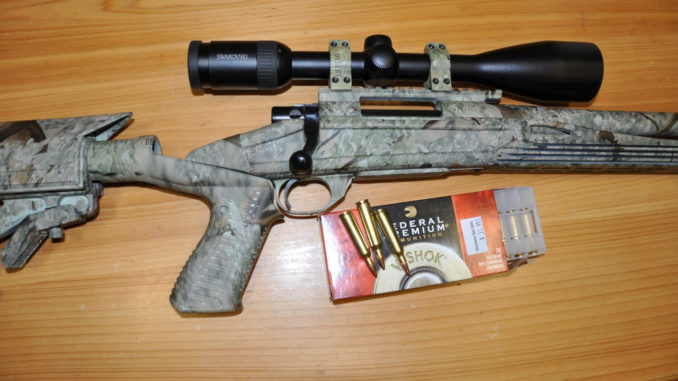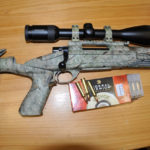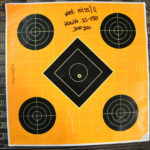
You’d better pack a lunch
I was more than a little frustrated, and embarrassed to boot.
Invited to Jeff and Karen Lewis’ Agriana Plantation in Tensas Parish, I had promised to help them sight in Karen’s new .22-250 bolt-action rifle.
I was really looking forward to the trip. Jeff loves to shoot, and has enough flat former cotton fields, acres of cypress brake and heavy oak bottoms to allow great distance shooting — shooting I rarely am able to enjoy anywhere else.
We had been sitting on the range all afternoon long, and the cursed rifle would not settle in.
I was pouring rounds through the barrel, cleaning it and watching groups go from reasonably good to just plain awful. Every eight to 10 rounds, I was giving the barrel a good scrubbing with a copper solvent, and then wiping the bore with Kano Kroil, the penetrating “oil that creeps.”
I had warned them the .22 centerfires sometimes need excessive shooting and cleaning to break in the barrel and get optimum accuracy. I hadn’t expected it to take as long as it was taking — and I had never sat down and tried to do it all in one afternoon.
To the non-participant, this process is about as exciting as watching paint dry. Shoot a group. Clean the barrel. Shoot a fouling shot. Watch the fouling shot go 6 inches out of the last group. See the next group larger than the last one. See the next group shoot as tight as the original. See the groups open up because the barrel is getting fouled again. Let the barrel cool. Repeat.
See what I mean?
Karen, who loves to shoot, finally wore out, and went back to the house. In Jeff’s favor, he is fascinated by engineering dilemmas, and the procedure of making the rifle shoot was intriguing him.
The last .22-250 I broke in and sighted was my own, the triangular-barreled Remington Varmint Tactical Rifle (VTR). Over several shooting sessions, I fired over 80 rounds before the barrel settled in and started giving me consistent groups.
I test fired it on Jeff’s range at 200 yards — it hit the aiming point with two shots that could be covered with a dime. I swabbed the barrel with a dry patch and put it up, gently encasing it in a hard-sided case. If I got a shot at a coyote, it would be this rifle I leveled on it.
Now, Karen’s rifle was giving me the same kind of fits. I was beginning to wonder if the Federal Premium bullets might be at fault. Maybe the rifle just didn’t like this particular load.
But it didn’t really make sense. The .22-250 is famous for its accuracy and amiable acceptance of a wide range of powders and bullets. Another name for an early version was the “.22 Varminter.” When you hear an old-timer refer to the round with that term, you know he’s been shooting rifles a long time.
So many factors must be taken into account when breaking in a new rifle. For instance, this was a Howa 1500 bolt action, but it was set in an after-market, injection molded stock by Blackhawk Products Group (www.blackhawk.com) called an Axiom.
This stock sports a pistol grip, and an expandable buttstock like those on many AR-15 style semi-auto rifles. It was this feature that attracted them — the length could be reduced, making the rifle much more comfortable for Karen to shoot.
Sometimes, aftermarket stocks are not as well-fitted as factory designs, and this lack of precision fit can seriously affect the rifle’s accuracy. Fortunately, this turned out to not be the case.
The bullets were 55-grain Sierra Game King Boat-Tail Hollow Points (BTHP). This weight is at the upper end of the most accurate weights for this caliber.
The SAAMI (Sporting Arms and Ammunition Manufacturers Institute) specifications call for an extremely slow 1 in 14 twist in the barrel. Thus, according to Remington engineers, my rifle (and most .22-250 barrels) would perform better (shoot tighter groups) with the lighter weight bullets. Over 55 grains, they said, and the slow twist just would not stabilize the bullet enough for optimum accuracy.
But Federal Premium carries a well-deserved reputation for quality and accuracy. The box claimed a muzzle velocity of 3,650 fps — pretty much an average velocity for a round that stayed around for decades after its stablemate, the .220 Swift, fell from favor for running out at over 4,000 feet per second, and burning up barrels.
Suddenly, shooting at 200 yards, I saw the rounds begin to fall into place. I asked Jeff to look through the spotting scope and watch.
“It’s starting to happen,” I said.
Six shots went into 2 inches at 200 yards. The Swarovski 5-25×52 was clear as a crisp fall morning, and I could see the bullet holes. Three of the shots were inside of an inch — all were dead center of the aiming point. We had finally, after 80+ rounds, polished out the bore, cleaned up the microscopic imperfections and deposited a copper film filling the tiny depressions. The rifle was finally behaving.
We decided to take one Hail Mary shot at 300 yards. The rifle was dead-point-of-aim at 200. The wind, erratic all afternoon, had died down. The light was starting to fade. It was time.
Taking as solid a rest as I could gain on my Caldwell Lead Sled, I placed the vertical crosshair bisecting the aiming circle in the center of the “Dirty Bird” splatter target — not the preferred choice for extreme long-range shooting, but that’s what we had left.
Taking a WAG (ballistically, a Wild-Ass Guess), I placed the horizontal crosshair 3.5 inches above the center aiming point, and carefully pushed the trigger on the HOWA 1500 action straight back.
We had to get in the Honda off-road vehicle to drive down to the target; at that range, even the spotting scope plays tricks with your eyes.
As we approached the target, we started giggling like idiots, the afternoon of shooting addling our brains.
The round had dropped 4 inches in the 100-yard distance from 200 to 300 yards, and had landed slightly below center horizontally, dead center vertically in the aiming circle. We drove back to the shooting bench with the target, and cradled the rifle like a newborn all the way back to the house.
Karen emailed the target to friends all over the country, and started hunting the rifle the next day. Jeff is forever borrowing it to carry in his truck, so another session is probably in the works for a new .22-250.




